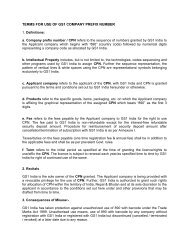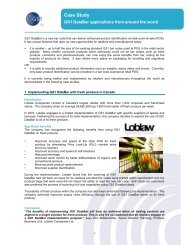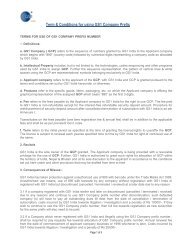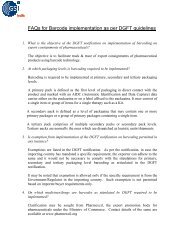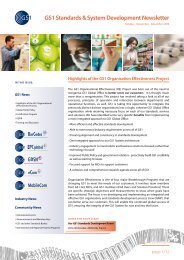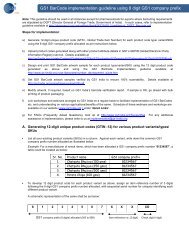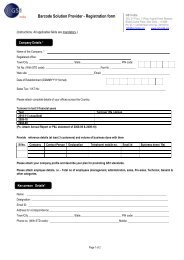Data Crunch report 2011 - GS1 India
Data Crunch report 2011 - GS1 India
Data Crunch report 2011 - GS1 India
Create successful ePaper yourself
Turn your PDF publications into a flip-book with our unique Google optimized e-Paper software.
C o n t e n t s<br />
Foreword .................................................................... 2<br />
Executive Summary ................................................. 3<br />
Background ................................................................5<br />
The Study .................................................................... 7<br />
Financial Impact ..................................................... 14<br />
Emerging <strong>Data</strong> Requirements ......................... 15<br />
Addressing the Challenges ............................... 16<br />
Appendix .................................................................. 17<br />
References ............................................................... 19
F o r e w o r d<br />
rganised retailing in <strong>India</strong> has been growing rapidly but<br />
O experiencing increasing cost pressures, some of which<br />
can be attributed to inefficiencies in Supply Chain business<br />
processes. One such area, often ignored, relates to product<br />
data quality management - capture / recording and<br />
seamless sharing of accurate, complete and updated<br />
product data between suppliers and retailers.<br />
With thousands of Stock Keeping Units (SKUs) currently<br />
stocked on retail shelves and new consumer products being<br />
introduced each month, maintenance of accurate master<br />
data with required product attributes becomes important<br />
since several retail operations connect the master data with<br />
ordering, replenishment, despatches and payment<br />
processes.<br />
of cost continues to restrict growth of retailing worldwide<br />
but can be avoided if suppliers and retailers agree to clean,<br />
align and synchronize product data in an automated<br />
manner using global data quality and Global <strong>Data</strong><br />
Synchronisation (GDS) standards through certified<br />
datapool services.<br />
As a part of the study in <strong>India</strong>, face to face meetings<br />
were held with cross-functional teams of some select<br />
<strong>India</strong>n suppliers and retailers to elicit as complete<br />
information as possible on product data captured and<br />
recorded by them. This painstaking work was undertaken<br />
by IBM <strong>India</strong> and we gratefully acknowledge their whole<br />
hearted support and efforts in providing their resources<br />
for the study.<br />
With the objective of bringing out its impact on retailing<br />
in <strong>India</strong>, the CII National Retail Committee decided to<br />
undertake a detailed study in 2009 - 2010. The study was<br />
conceptualized and led by <strong>GS1</strong> <strong>India</strong>, a not-for-profit<br />
standards organisation under Ministry of Commerce,<br />
Government of <strong>India</strong> in collaboration with IBM <strong>India</strong>.<br />
The <strong>India</strong> study was as significant and as dramatic in terms<br />
of findings and outcomes which are captured in this <strong>report</strong>.<br />
We hope this would serve as an eye opener to the retail<br />
sector and help them in understanding the grave impact<br />
of poor data quality on top line as well as bottom line<br />
performance of organisations.<br />
<strong>GS1</strong> is involved in development and implementation of<br />
global, open, interoperable and user driven standards<br />
used in Supply Chain Management, collaboratively with<br />
Industry, which facilitate physical flow of goods and<br />
related electronic information flow among Supply Chain<br />
partners.<br />
The study was modelled on a similar survey undertaken in<br />
U.K. by IBM [1] which brought out dramatic results in terms<br />
of the extremely high level of mismatches and inaccuracies<br />
in product data maintained by suppliers and retailers. It<br />
was estimated to cost the retail sector in U.K. £1 billion in<br />
five years.<br />
With margins already under tremendous strain, such kind<br />
The study points clearly towards the need for product data<br />
cleansing through adoption and implementation of <strong>GS1</strong><br />
standards and Global <strong>Data</strong> Synchronisation Network (GDSN)<br />
service by both suppliers and retailers in <strong>India</strong>.<br />
The above would enable the <strong>India</strong>n retail sector to realise<br />
efficiencies and benefits which have accrued to suppliers<br />
and retailers worldwide on addressing product data quality<br />
issues and implementing data synchronisation.<br />
We urge the Industry to take cognizance of this important<br />
<strong>report</strong> and proactively implement its recommendations. It<br />
would help the <strong>India</strong>n retail and CPG sector integrate with<br />
global best practices, improve their performance and<br />
service levels to <strong>India</strong>n consumers.<br />
Thomas Varghese<br />
Chairman, CII National Retail Committee<br />
CEO, Aditya Birla Retail Limited.<br />
Ravi Mathur<br />
Chairman, CII National Retail Sub - Committee on IT & Standards<br />
CEO, <strong>GS1</strong> <strong>India</strong><br />
The <strong>India</strong> <strong>Data</strong> <strong>Crunch</strong> Report <strong>2011</strong><br />
2
E x e c u t i v e S u m m a r y<br />
Organised retailing in <strong>India</strong> needs addressing several<br />
issues/challenges related to infrastructure, logistics,<br />
taxation etc. Many of these require intervention by policy<br />
making bodies for their satisfactory resolution. There are<br />
however areas which can be expeditiously addressed through<br />
collaboration between trading partners by adoption of<br />
Information Technology (IT) enabled applications and global<br />
standards.<br />
It can significantly and positively impact operational<br />
efficiency / productivity, administrative costs resulting in<br />
increased sales, lower logistics costs, enhanced consumer<br />
satisfaction and a win-win opportunity for all trading<br />
partners.<br />
Success in retailing is contingent on effective management<br />
of product master data through maintenance of a single,<br />
trusted, accurate, fully updated and complete product item<br />
master which can be relied upon by retailers and their<br />
suppliers.<br />
Good quality data ensures that all master data in the Supply<br />
Chain is complete, consistent, accurate, time-stamped and<br />
industry standards-based and also allows effective<br />
collaboration among trading partners. It is not only vital<br />
to reducing errors but fundamental to increasing efficiency,<br />
reducing costs and positively impacting customer<br />
satisfaction.<br />
Due to the persistent<br />
exchange of inaccurate<br />
product data among Rs 40 to 50 billion -<br />
Estimated loss over next<br />
trading partners,<br />
5 years due to poor data.<br />
benefits cannot be<br />
realized and optimized<br />
from the use of IT tools, applications and technologies<br />
such as Enterprise Resource Management (ERP),<br />
Customer Relationship Management (CRM). This in<br />
turn impacts significantly the returns which can be<br />
realised on investment in IT by an organisation.<br />
To study and evaluate its impact on business operations<br />
and<br />
provide<br />
recommendations to the<br />
<strong>India</strong>n Retail and CPG 70% - Average level of<br />
product data<br />
Industry for addressing<br />
inconsistency across<br />
the same, a detailed<br />
Retail sector.<br />
survey was undertaken in<br />
2009-10 by the CII<br />
National Retail<br />
Committee.<br />
One such area which is at the core of mission critical retail<br />
operations relates to accuracy of master data of traded<br />
SKU’s. This is extensively used in facilitating several<br />
applications related to ordering, despatch, inspection,<br />
invoicing, stock management, replenishment, category<br />
management, planogram planning, demand forecasting,<br />
reverse logistics, consumer billing, warehouse<br />
management etc.<br />
<strong>GS1</strong> <strong>India</strong> led the study with project execution leadership<br />
by IBM <strong>India</strong>.<br />
The study was modelled on a similar study undertaken by<br />
IBM in the U.K. [1]. Four major <strong>India</strong>n retailers and four<br />
leading CPG brand owners participated by sharing details<br />
on the status of their respective product master data as<br />
requested through the study questionnaire.<br />
3<br />
The <strong>India</strong> <strong>Data</strong> <strong>Crunch</strong> Report <strong>2011</strong>
The data supplied by each participant was collated,<br />
compiled and analyzed for correctness and completeness<br />
with respect to <strong>GS1</strong> Standards. The level of data<br />
inconsistency was determined by comparing the retailer<br />
and supplier data on a common set of parameters / data<br />
attributes.<br />
The impact on business operations was then tabulated to<br />
demonstrate the linkage between data quality and business<br />
results. The impact on organisational performance was<br />
tabulated under three broad categories covering loss of<br />
revenue, additional costs incurred and opportunity costs.<br />
This included fill rate loss, deductions, administrative<br />
shrinkage, loss of man-hours on duplication of work and<br />
time / efforts spent in resolution of errors etc.<br />
Study recommends adoption of global data quality<br />
and product data synchronisation standards by<br />
retailers and their suppliers.<br />
The study revealed startling results on the extent of<br />
inconsistency in product master data between retailers<br />
and suppliers which exceeded 70%. Estimated losses on<br />
account of the same which could get sustained by the<br />
<strong>India</strong>n Retail and CPG sector over a five year period pointed<br />
to losses of between Rs 40 - 50 billion due to data<br />
inconsistency and subsequent errors.<br />
In a sector like retailing with relatively small net profit<br />
margins, such losses could significantly impact overall<br />
profitability of trading partners if not addressed through<br />
collaborative efforts.<br />
In its recommendation, the <strong>report</strong> urges <strong>India</strong>n retailers<br />
and suppliers to adopt and implement global standards<br />
for data structure, data validation, its communication and<br />
updation following global best practices and standards.<br />
The <strong>report</strong> also recommends adoption and<br />
implementation of Global <strong>Data</strong> Synchronization Network<br />
(GDSN) through subscription to a certified GDSN datapool<br />
service provider. The standards for the same, called GDSN<br />
Standards, have been developed by <strong>GS1</strong> through active<br />
participation of various stakeholders representing retailers,<br />
CPG companies etc.<br />
<strong>India</strong> has the opportunity to benefit from the maturity<br />
level that GDSN has attained over the last few years and<br />
can speed up its adoption without having to expend efforts<br />
and delays in starting from scratch.<br />
The <strong>India</strong> <strong>Data</strong> <strong>Crunch</strong> Report <strong>2011</strong><br />
4
B a c k g r o u n d<br />
Organised retailing, in <strong>India</strong>, has gone through phases of<br />
rapid expansion, uncertainty and slowdowns constantly<br />
in the past few years. While it has endeavored to deliver<br />
superior store experience to consumers, it has struggled<br />
with on-shelf availability of products, poor fill rates and<br />
timely replenishments.<br />
Out of Stocks (OOS) is an industry wide problem and results<br />
in avoidable loss of revenue to both suppliers and retailers.<br />
Amongst other factors, it is significantly dependent on<br />
quality of product master data as well as its accuracy and<br />
timely update.<br />
Issues such as OOS, purchase order (PO) errors and<br />
operational inefficiencies due to master data challenges<br />
are not unique to <strong>India</strong>. Many global studies have<br />
highlighted how supply chain data management issues<br />
continue to restrict growth of organised and modern<br />
retailing.<br />
A similar study undertaken in the U.K. grocery industry [1]<br />
identified that discrepancy and inconsistency issues related<br />
to supply chain data in the retail industry were significant<br />
The <strong>India</strong> <strong>Data</strong> <strong>Crunch</strong> study was proposed by the<br />
Chairman (CEO, <strong>GS1</strong> <strong>India</strong>) of the CII National Retail<br />
Sub - Committee on IT & Standards to the<br />
Chairman (CEO , ABRL) of CII National Retail<br />
Committee to evaluate impact of poor<br />
data quality on the <strong>India</strong>n Retail sector and provide<br />
recommendations on addressing the same.<br />
reasons for shrinking profit margins. The U.K. Study Report<br />
also revealed that individual retailers and suppliers did<br />
not share product data among themselves. There was<br />
therefore no mechanism in place for both retailers and<br />
suppliers to check the consistency of product data<br />
maintained by each.<br />
An additional issue is retailers’ lack of trust in suppliers’<br />
data. It results in each maintaining its own individual<br />
product master data. Not only does this result in data<br />
discrepancies along the supply chain, it also leads to<br />
huge operational costs for retailers in maintaining<br />
separate and different product master data and trying<br />
to correlate the same to the master data maintained by<br />
their suppliers.<br />
5<br />
The <strong>India</strong> <strong>Data</strong> <strong>Crunch</strong> Report <strong>2011</strong>
It is evident that in order to overcome these supply chain<br />
inconsistencies, a collaborative effort involving retailers<br />
and suppliers is required.<br />
etc [2]. The performance metrics of suppliers and retailers<br />
surveyed and impacted in this <strong>report</strong> have been<br />
summarised in figure 1.<br />
In this direction, a joint industry initiative that allows<br />
retailers, distributors and suppliers to manage and share<br />
accurate product data in a single master data system is the<br />
appropriate solution. Suppliers and retailers can both<br />
benefit from this joint industry initiative by enhancing<br />
their common key performance indicators (KPIs) such as<br />
increasing sales, improving productivity, reducing costs<br />
To study the problem and provide recommendations to<br />
the <strong>India</strong>n Retail sector on addressing the same, it was<br />
proposed by the Chairman (CEO, <strong>GS1</strong> <strong>India</strong>) of the CII<br />
National Retail Sub - Committee on IT and Standards to<br />
the Chairman (CEO, ABRL) of CII National Retail Committee<br />
to conduct an “<strong>India</strong> <strong>Data</strong> <strong>Crunch</strong> study”, on lines of the<br />
one conducted in the U. K.<br />
Costs<br />
Sales / Revenue<br />
Operational / capital costs<br />
Financial & Admin costs due to invoice & PO<br />
errors<br />
Labour costs due to invoice & PO errors<br />
Transportation costs<br />
Inventory holding costs<br />
Reduced time to market<br />
Lost sales due to data errors<br />
Lower fill rates hence higher out of stocks<br />
Man-hours / Labour saving<br />
Efficiency<br />
Time spent by the buyer / merchandiser in<br />
creation and management of items<br />
Time spent by Finance & DC executives in sorting<br />
invoice & PO errors<br />
Duplication of efforts<br />
Improved processes<br />
Improved productivity<br />
Improved agility<br />
Reduced errors<br />
<strong>Data</strong> Management<br />
Consumer Experience<br />
Master data management<br />
PO & invoice data management<br />
Product attribute data management<br />
Improved stock availability<br />
Stock freshness<br />
Access to accurate and reliable product<br />
information<br />
Figure 1 : Business Metrics / KPIs affected by data quality<br />
The <strong>India</strong> <strong>Data</strong> <strong>Crunch</strong> Report <strong>2011</strong><br />
6
T h e S t u d y<br />
Scope & Methodology<br />
The study scope included a survey on extent of data<br />
inaccuracy / inconsistency in product master data<br />
maintained by retailers and suppliers. This survey was<br />
conducted in two phases.<br />
Phase I<br />
<strong>Data</strong> sets were collected both from retailers and suppliers<br />
for an identical set of product data parameters / attributes<br />
and were analysed for measuring the extent of discrepancy<br />
between them. The data was then compared on the same<br />
products as maintained by each participant<br />
retailer using <strong>GS1</strong> standards for unique identification of<br />
SKU’s through use of Global Trade Identification Numbers<br />
(GTINs) as product identifiers. Results obtained by<br />
comparing product data held by the four retailers were<br />
then matched with the same held by four major<br />
suppliers.The step by step procedure followed in this phase<br />
has been summarised in figure 2.<br />
Step 1<br />
Collection of data files from retailers<br />
Step 2<br />
Review of retailers’ data files to check completeness<br />
Step 3<br />
Comparison among retailers’ data files for products with same GTINs<br />
Step 4<br />
Collection of data files from suppliers<br />
Step 5<br />
Review of suppliers’ data files to check completeness<br />
Step 6<br />
Comparison among suppliers’ and retailers’ data files for products with same GTINs<br />
Figure 2 : Phase I<br />
7<br />
The <strong>India</strong> <strong>Data</strong> <strong>Crunch</strong> Report <strong>2011</strong>
Phase II<br />
<strong>Data</strong> was collected through face to face interactions with<br />
each participant. Survey results reflected the issues and<br />
challenges experienced in day to day operations on account<br />
of poor data quality. The step by step procedure followed<br />
in this phase has been summarized in figure 3.<br />
Participants from the retailer community comprised large<br />
retail chains operating different retail formats with a pan-<br />
<strong>India</strong> presence. Participants from the supplier community<br />
comprised of large multinationals and <strong>India</strong>n Consumer<br />
Packaged Goods (CPG) manufacturers.<br />
Step 1<br />
Preparation of questionnaire for interviewing participants<br />
Step 2<br />
Review of questionnaire with Industry<br />
Step 3<br />
Sending of questionnaire to the survey participants<br />
Step 4<br />
Collection of inputs through face to face interviews<br />
Step 5<br />
Consolidation of received data<br />
Step 6<br />
Arrival of Industry averages to derive inferences<br />
Figure 3 : Phase II<br />
Study Challenges<br />
1. Product data maintained by retailers was being done<br />
at their internal item code level which was frequently<br />
linked with multiple <strong>GS1</strong> (EAN / UPC) codes for a<br />
single item / SKU / product. This made it difficult to<br />
compare product data between retailers.<br />
2. Prevalence of same item (SKU) with multiple MRPs<br />
(maximum retail prices), made it difficult to compile<br />
data on all available MRP’s for a single item.<br />
3. Use of different units of measure / attributes in item<br />
measurement and different conversion factors used,<br />
made it difficult to compare data accurately at desired<br />
precision levels.<br />
4. Dummy entries with a value of 1 in several product data<br />
fields to satisfy system data entry validation<br />
requirements, made it difficult to differentiate between<br />
a genuine value and a dummy value.<br />
5. Obtaining master data on 30 identified product attributes<br />
was a challenge as many of the participants were<br />
maintaining data in multiple IT systems under different<br />
data owners within the same organisation.<br />
The <strong>India</strong> <strong>Data</strong> <strong>Crunch</strong> Report <strong>2011</strong><br />
8
Findings<br />
1. One item- multiple <strong>GS1</strong> codes<br />
a. It was observed that three out of four retailers had 28<br />
to 53% of their internal item codes associated with<br />
two or more <strong>GS1</strong> codes. (figure 4)<br />
b. While having multiple <strong>GS1</strong> codes associated with a<br />
single internal item code made retailers’ efforts for<br />
new item creation easy, it showed negative impact on<br />
efficiencies of shelf life management, promotion<br />
handling and planogram planning.<br />
2. Low correlation of data between retailers<br />
The data files provided by all four retailers had a<br />
significant amount of information missing or<br />
contained ‘dummy entries’ (e.g. 1x1x1 size<br />
dimensions) to satisfy system data entry validation<br />
requirements. In order to normalize the results, null<br />
entries and dummy data were omitted during<br />
comparisons.<br />
Analysis revealed an extremely low correlation between<br />
the data held on identical products by the four<br />
retailers. The correlation was quite low when the<br />
comparison was done considering data received from<br />
any three of the retailers.<br />
The average exact match of data received from four retailers<br />
for the same SKU was less than 50% across parameters /<br />
attributes, barring a few attributes like MRP and product<br />
dimensions which showed close to 0% match.<br />
This was a clear indication of inefficient master data<br />
sharing among supply chain partners. Retailers<br />
seemed to maintain their own version of data instead<br />
of using a single common version available from the<br />
suppliers. The multiple versions of data being<br />
maintained across a Retail organisation also resulted<br />
in data inconsistencies within the same organisation.<br />
Figure 4 : One item with multiple <strong>GS1</strong> codes<br />
9<br />
The <strong>India</strong> <strong>Data</strong> <strong>Crunch</strong> Report <strong>2011</strong>
Weight mismatch<br />
(±10% tolerance)<br />
minimum : 49%<br />
maximum : 89%<br />
These data discrepancies could cause problems in<br />
invoice matching and show up in apparent stock<br />
‘shrinkage’, unexpected stock outs, and under / over<br />
payments to suppliers.<br />
Any two<br />
retailer files<br />
4. Case level dimension data not used by Retailers<br />
Case / carton dimensions were not captured by<br />
retailers even though the same were available with<br />
the suppliers.<br />
Dimension mismatch<br />
(±10% tolerance)<br />
minimum : 39%<br />
maximum : 80%<br />
Dimension mismatch<br />
(without tolerance)<br />
minimum : 97%<br />
maximum : 100%<br />
Figure 5 : Comparison between retailer files on weight<br />
and dimensional data at SKU level<br />
This data could be very useful for suppliers in<br />
warehouse and transportation planning but was not<br />
being used. It could also be leveraged by retailers<br />
for their Distribution Centre (DC) space planning,<br />
transportation planning and backend retail stores<br />
space planning but was not being done.<br />
Units per case<br />
mismatch<br />
Shelflife<br />
mismatch<br />
Among four<br />
retailers : 99%<br />
Among three<br />
retailers : 78%<br />
Among four<br />
retailers : 93%<br />
Among three<br />
retailers : 71%<br />
Figure 6 : Comparison between retailer files on units per case and shelf life<br />
Width<br />
Length<br />
3. Extremely low correlation of data between Retailers<br />
and Suppliers<br />
The survey matched data held by each of the four<br />
retailers with the data held by the suppliers. Less than<br />
30% of the data held by retailers matched with the<br />
product data available from suppliers. Certain<br />
attributes like MRP and dimensions showed close to<br />
0% match.<br />
Depth<br />
Figure 7 : Case level dimensional attributes<br />
The <strong>India</strong> <strong>Data</strong> <strong>Crunch</strong> Report <strong>2011</strong><br />
10
The result was sub-optimal truck loading, road<br />
congestion and enhanced avoidable logistics<br />
costs.<br />
5. Supplier data more complete<br />
Supplier data in general, appeared to be more<br />
complete in comparison to retailer data. Retailers<br />
did not seem to capture SKU / case dimensional<br />
data and shelf life data. All suppliers had<br />
complete case level dimensional data which was<br />
more accurate as compared to item level<br />
dimensional data.<br />
Out of the four, only two retailers were<br />
maintaining item level dimensional data.<br />
Not all retailers were maintaining accurate<br />
and exact data about shelf life and<br />
case configuration.<br />
Retailer Files status -<br />
Missing dimensional data,<br />
incomplete case configuration &<br />
shelf life.<br />
Survey outcome - insights<br />
1. Fill Rate & Fill Rate Loss<br />
In the second phase of the study, fill rates and fill rate<br />
losses across the industry were analysed based on the<br />
questionnaire responses received from participant<br />
retailers and suppliers:<br />
a. Fill rates between suppliers and retailers varied between<br />
60 - 80%. Almost 10 - 15% drop in fill rate was attributed<br />
to discrepancy in product master data.<br />
b. Fill rate maintained at retailer DC’s also varied between<br />
Figure 8 : Retailer data file<br />
60 - 90%. Some retailers maintained the same fill rate<br />
as that of their suppliers and this contributed frequently<br />
to OOS at their stores. Other retailers carried extra<br />
inventory at their DC’s as buffer to manage lower fill<br />
rates of the suppliers.<br />
c. Fill rate loss due to data errors was contributing to out<br />
of stocks and increased inventory and inventory<br />
carrying costs.<br />
Supplier DC<br />
Retailer DC<br />
Retail<br />
Store<br />
Supplier to retailer<br />
Retailer DC to Store<br />
Fill rate : 60 - 70%<br />
FR Loss* : 10 - 15 %<br />
Fill rate : 65 - 90%<br />
FR Loss* : 5 - 10 %<br />
* Due to data errors<br />
Figure 9 : Fill rate losses<br />
11<br />
The <strong>India</strong> <strong>Data</strong> <strong>Crunch</strong> Report <strong>2011</strong>
2. SKU data management<br />
Both retailers and suppliers spend considerable time<br />
in maintenance and management of their product<br />
data masters. Average time spent on the same by each<br />
consumed 10 - 30% of their productive working time.<br />
This amounted to 25 - 100 man-hours loss per month<br />
(figure 10).<br />
At Supplier end<br />
Productive time spent on managing & sending item information to retailers 10 - 15%<br />
Man hours spent managing item information in a month<br />
Time required to create and update a new SKU<br />
25 - 99 hrs.<br />
2 - 15 days<br />
At Retailer end<br />
Productive time spent on managing item information 10 - 30%<br />
Man hours spent managing item information in a month<br />
Time required to create and update a new SKU<br />
12 - 50 hrs.<br />
2 - 5 days<br />
Figure 10 : SKU data management<br />
3. Invoice & Purchase Order (PO) errors<br />
Frequent errors were encountered in invoices and<br />
purchase orders on account of master data inaccuracy.<br />
Substantive time / efforts, which were not quantified,<br />
were spent in correcting the same (figure 11) by each<br />
survey participant.<br />
Invoice and PO errors impacted multiple functions<br />
which included buying, merchandising, finance, and<br />
logistics. Delays were also encountered on account of<br />
unavailability of relevant staff for undertaking<br />
validation and authorisation processes.<br />
At Supplier end<br />
Invoices with errors 5 - 10%<br />
Time spent by merchandising team in reconciling invoice & PO errors 15 - 30%<br />
Time spent by DC team in reconciling invoice & PO errors 10 - 20%<br />
At Retailer end<br />
POs with errors 15 - 30%<br />
Time spent by merchandising team in reconciling invoice & PO errors 15 - 30%<br />
Time spent by DC team in reconciling invoice & PO errors 10 - 20%<br />
Figure 11 : Invoice & PO errors<br />
The <strong>India</strong> <strong>Data</strong> <strong>Crunch</strong> Report <strong>2011</strong><br />
12
4. Returns & Invoice deductions<br />
Prevalence of product returns and invoice deductions<br />
on account of the same were common practice as stated<br />
by all survey participants. This had direct financial impact<br />
on suppliers who had to incur additional transportation<br />
costs and efforts in receiving returned products, handling<br />
damages and shrinkages etc (figure 12).<br />
At Supplier end<br />
Shipments with returns 5 - 10%<br />
Units returned
F i n a n c i a l I m p a c t<br />
Based on the data collected from the respones received<br />
to the questionnaire in Phase II, an assessment on the<br />
financial impact of poor quality data was calculated and<br />
the same is reflected through figures 14 & 15.<br />
It is estimated that the cumulative impact of poor master<br />
data would result in industry losses to the tune of Rs 40 to<br />
50 billion in next five years if unresolved.<br />
The problem will amplify considering that the <strong>India</strong>n<br />
retail sector is poised for rapid growth in the next few<br />
years (estimated as US$ 804.6 million by 2015) [3]<br />
and impending entry of new players.<br />
The need therefore for better quality and improved<br />
management of product data is significant and<br />
growing. The current tactical approach of developing<br />
local processes and fixes to work around bad product<br />
data is no longer adequate and results in significant<br />
costs to both retailers and their suppliers.<br />
Lost sales per year in CPG Retailing due to product data inconsistencies 2.30 - 2.50<br />
Lost revenue per year in CPG Retailing due to deductions on invoice value 1.20 - 3.00<br />
Lost sales per year in CPG Retailing due to out of stocks attributed to data errors 2.70 - 3.00<br />
Additional inventory holding cost per year in CPG Retailing to account for fill rate<br />
loss due to product master data errors 0.06 - 0.10<br />
Figure 14 : Lost Revenues in CPG retailing (in Rs billion)<br />
Transportation inefficiency cost due to unused / incomplete / incorrect product<br />
dimension and weight data 0.03 - 0.05<br />
Costs associated with efforts taken by the Retailers and Suppliers on reconciliation of<br />
PO and invoices errors within their organisation 0.02 - 0.03<br />
Additional cost incurred in reverse logistics assuming 10% shipment returns 0.02 - 0.04<br />
Estimated savings in store rentals due to better utilization of space using product<br />
dimension data 1.10 - 1.20<br />
Retail shrinkage due to product master data errors 1.10 - 1.20<br />
Figure 15 : Additional costs in CPG retailing (in Rs billion)<br />
Costs due to duplication of work at ware house, damage and shrinkage of<br />
products in transit<br />
?<br />
(not tabulated)<br />
Figure 16 : Intangible costs<br />
Financial impact due to poor product data - Rs 8 to 10 billion per year (Rs 40 to 50 billion in 5 years).<br />
Financial calculations exclude several other intangible costs due to which actual losses could be higher than<br />
the amounts estimated above.<br />
The <strong>India</strong> <strong>Data</strong> <strong>Crunch</strong> Report <strong>2011</strong><br />
14
E m e r g i n g D a t a R e q u i r e m e n t s<br />
R<br />
etailers and suppliers are continuosly looking at<br />
speed to market and to utilise warehouses, delivery<br />
vehicles and shelf space more optimally. Key Performance<br />
Indicators (KPIs) funnel down to two imperatives –<br />
increasing Sales and reducing costs.<br />
Environment, Packaging and Legislation<br />
Governments, Regulatory bodies and retailers will require<br />
timely information regarding packaging waste, detailed<br />
tax information, carbon footprint etc.<br />
While the objectives are clear, there is little understanding<br />
of just how far collaboration between suppliers and retailers<br />
can deliver sales growth and cost economies, based on<br />
accurate, clean and consistent product data.<br />
An additional compelling reason for retailers and suppliers<br />
to take action to improve efficiency and manage the quality<br />
of product data more effectively, is the increasing demand<br />
for more data on products consumed coming from<br />
consumers, Governments, Regulators etc.<br />
These trends suggest that retailers will need to collate,<br />
store, manage and <strong>report</strong> on increasing product attributes.<br />
Additional data will be required to address demand for<br />
information in the following areas:<br />
Supply Chain<br />
Currently there are more than 200 <strong>GS1</strong> standard product<br />
attributes. On an average, only 66 product attributes are<br />
being used by retailers and suppliers. Considering the<br />
increase in the diversity of products and product<br />
sourcing, demand and usage of attributes will increase<br />
in the next four to five years as the need for additional<br />
product information increases, e.g. Price, Handling<br />
instructions, Traceability attributes, product<br />
classification etc.<br />
Health and Wellness<br />
Consumers today are increasingly conscious of their health<br />
and wellness with rising income levels. They are demanding<br />
more information on same on the products they consume.<br />
Demand for data, such as nutritional information,<br />
allergens, sustainability, is increasing and driven by the<br />
consumer using new channels like mobile phones, internet<br />
ordering etc.<br />
15<br />
The <strong>India</strong> <strong>Data</strong> <strong>Crunch</strong> Report <strong>2011</strong>
A d d r e s s i n g t h e C h a l l e n g e s<br />
he time has arrived for the <strong>India</strong>n CPG & retail industry<br />
T to address the data quality issue head on, and reap the<br />
benefits.<br />
According to a recent <strong>GS1</strong> benchmark, over 30% of global<br />
trading volume is now transacted using data<br />
synchronisation through GDSN certified data pools.<br />
Given the importance of maintaining an accurate and<br />
consistent product master data, there is need for the<br />
Industry to come together and address data related<br />
problems and inefficiencies through collaborative efforts.<br />
The problem needs to be recognised as a key strategic<br />
issue at the highest level within supplier and retailer<br />
communities on its impact to the top-line and bottomline<br />
performances of organisations.<br />
<strong>Data</strong> synchronisation through GDSN certified data pools<br />
alongwith use of <strong>GS1</strong> data accuracy / validation guidelines<br />
can be adopted towards resolving the quality and accuracy<br />
issues.<br />
The <strong>India</strong>n organised retail sector can benefit from the<br />
experience of global community and adopt these standards<br />
without having to go through the pain points experienced<br />
earlier worldwide.<br />
GDSN is an internet-based network of interoperable data<br />
pools that enable retailers and suppliers to exchange<br />
standardised and synchronised Supply Chain data with<br />
trading partners. The diagram (figure: 17) elaborates the<br />
process of a GDSN based solution.<br />
Retailers can save the time and effort they currently devote<br />
in creating their own product data files in separate stores,<br />
warehouses, buying divisions and merchandising<br />
departments. Everyone draws from the same product data<br />
pool which means everyone has access to consistent<br />
information because there is only one trusted source of<br />
product information for all.<br />
This collaborative approach assures the quality of<br />
product data and creates trust between retailers and<br />
suppliers, eliminating many of the workaround activities<br />
currently employed to address errors.<br />
A series of real-life case studies have been compiled in the<br />
GCI-Capgemini Report [2] which demonstrates that data<br />
synchronisation reduces costs, improves productivity,<br />
increases sales and provides the essential foundation for<br />
collaboration among trading partners.<br />
The study concludes by recommending adoption and<br />
implementation of a GDSN certified datapool service in <strong>India</strong><br />
utilising the expertise, services and local facilitation support<br />
of <strong>GS1</strong> <strong>India</strong> to address the challenges being faced. This is an<br />
initiative which can be rolled out with speed through<br />
collaboration between retailers and their suppliers.<br />
Figure 17 : Schematic diagram<br />
The <strong>India</strong> <strong>Data</strong> <strong>Crunch</strong> Report <strong>2011</strong><br />
16
A p p e n d i x<br />
Appendix 1 - Study Results Tables<br />
A. <strong>Data</strong> received from Retailers<br />
Parameters Retailer 1 Retailer 2 Retailer 3 Retailer 4<br />
Total number of <strong>GS1</strong> codes available for analysis 1014 3265 1735 1313<br />
Items where multiple <strong>GS1</strong> codes are mapped<br />
with a single internal item code 60% 18% 43% 0%<br />
Items where single <strong>GS1</strong> code is mapped<br />
with multiple internal item codes 0.4% 0% 0% 0.7%<br />
Items with missing / incorrect <strong>GS1</strong> codes 3% 0% 0% 1%<br />
Items with missing MRPs 9% 4% 0% 0%<br />
Items with missing vendor / supplier codes 65% 100% 100% 100%<br />
Items with unrecorded / zero shelf life 51% 18% 24% 31%<br />
Cases with missing data on units per case 5% 1% 0% 0%<br />
Items with missing / incorrect dimensional data 38% 1% 100% 100%<br />
Items with missing weight data 9% 5% 99% 100%<br />
Cases with missing dimensional data 29% 100% 100% 100%<br />
Cases with missing weight data 29% 100% 100% 100%<br />
Under 40% match 40 - 70% match 70 - 100% match<br />
B. Comparison of data across Retailers<br />
B1. Comparison of Retailer data files on units per case, shelf life and MRP<br />
Exact match<br />
Attributes Attributes matched Attributes matched Attributes matched<br />
across 4 retailers across 3 retailers across 2 retailers<br />
Units per case 1% 22% 66%<br />
Shelf life 7% 29% 65%<br />
MRP 42% 82% 91%<br />
Under 40% match 40 - 70% match 70 - 100% match<br />
Shelf life data is critical for ensuring product freshness. Any discrepancy in shelf life can have financial impact<br />
as well as safety concern<br />
Case configuration data if incorrect can also result in financial impact when used in calculating the units<br />
received / invoiced<br />
MRP is the only parameter which shows match at a reasonable level (discrepancy is attributable to human<br />
error and not updated systems)<br />
Only exact data match considered<br />
B2. Comparison of any two Retailer data files for SKU level dimensional data<br />
Attributes Exact match Match with ±10% tolerance<br />
Length 1% 23%<br />
Width 2% 13%<br />
Height 7% 49%<br />
Volume 1% 22%<br />
Net weight 51% 55%<br />
Under 40% match 40 - 70% match<br />
70 - 100% match<br />
Besides net weight, all dimensional parameters showed high level of data inconsistency<br />
Even after applying a tolerance of ±10%, none of the parameters showed more than 70% match<br />
17<br />
The <strong>India</strong> <strong>Data</strong> <strong>Crunch</strong> Report <strong>2011</strong>
C. Comparison of data between Retailers & Suppliers<br />
C1. Comparison with four Retailer data<br />
Exact match<br />
Attributes Supplier 1 Supplier 2 Supplier 3 Supplier 4<br />
Net Weight 32% 67% 24% 0%<br />
Length 0% 0% 0% 0%<br />
Width 0% 0% 0% 4%<br />
Height 0% 0% 0% 0%<br />
Volume 0% 0% 0% 0%<br />
With ±10% tolerance<br />
Attributes Supplier 1 Supplier 2 Supplier 3 Supplier 4<br />
Net Weight 45% 70% 43% 19%<br />
Length 29% 0% 22% 38%<br />
Width 10% 0% 24% 42%<br />
Height 48% 0% 18% 48%<br />
Volume 12% 0% 8% 23%<br />
Under 40% match 40 - 70% match 70 - 100% match<br />
There is a significant discrepancy between retailer and supplier dimensional data in case of exact match<br />
Even with ± 10% tolerance, discrepancy does not improve much<br />
Retailers are maintaining their own version of data which is further impacted by manual errors<br />
C2. Comparison with two Retailer data<br />
Attributes Supplier 1 Supplier 2 Supplier 3 Supplier 4<br />
Dimension per case 3% 3% 0% 0%<br />
Shelflife 0% 8% 0% 0%<br />
MRP 42% 23% 62% 33%<br />
Under 40% match 40 - 70% match 70 - 100% match<br />
There is significant discrepancy between retailer and supplier data<br />
Retailers are maintaining their own version of data which is further impacted by manual errors<br />
Inconsistency in Retailer data would not arise in event all retailers use supplier provided product data,<br />
instead of creating their own<br />
The <strong>India</strong> <strong>Data</strong> <strong>Crunch</strong> Report <strong>2011</strong><br />
18
R e f e r e n c e s<br />
1. “<strong>Data</strong> <strong>Crunch</strong> Report - The Impact of Bad <strong>Data</strong> on Profits and Consumer Service in the U.K. Grocery Industry”, Published<br />
by <strong>GS1</strong> U.K., October 2009<br />
2. “Global <strong>Data</strong> Synchronisation at work in the real world - illustrating the business benefits”, Capgemini Global Commerce<br />
Initiative, March 2005<br />
3. “The Business Monitor International (BMI) <strong>India</strong> Retail Report for the fourth-quarter of <strong>2011</strong>”<br />
19<br />
The <strong>India</strong> <strong>Data</strong> <strong>Crunch</strong> Report <strong>2011</strong>
A b o u t G S 1 I n d i a<br />
®<br />
<strong>GS1</strong> is a neutral, not-for-profit organisation that<br />
facilitates collaboration amongst trading partners and<br />
technology providers, in order to solve together business<br />
challenges that leverage standards and to ensure safety,<br />
efficiency and visibility along the entire value chain.<br />
Headquartered at Brussels, <strong>GS1</strong> oversees a global<br />
network of over 100 <strong>GS1</strong> organisations serving over 150<br />
countries. <strong>GS1</strong> <strong>India</strong> is an affiliate of <strong>GS1</strong>.<br />
<strong>GS1</strong> <strong>India</strong> was setup as a not-for-profit standards body<br />
in 1996 by the Ministry of Commerce, Government of<br />
<strong>India</strong> and leading Chambers of Commerce comprising<br />
CII, FICCI, ASSOCHAM, IMC, FIEO besides BIS, IIP, Spices<br />
Board and APEDA. It promotes awareness on <strong>GS1</strong><br />
standards and solutions and supports their<br />
implementation in line with the overall global objectives<br />
of <strong>GS1</strong>.<br />
A b o u t C I I<br />
The Confederation of <strong>India</strong>n Industry (CII) works to create<br />
and sustain an environment conducive to the growth of<br />
industry in <strong>India</strong>, partnering industry and government alike<br />
through advisory and consultative processes. CII is a nongovernment,<br />
not-for-profit, industry led and industry<br />
managed organisation, playing a proactive role in <strong>India</strong>’s<br />
development process.<br />
of over 90,000 companies from around 400 national and<br />
regional sectoral associations.<br />
The CII National Committee on Retail has been set up to<br />
address issues that hinder the growth of organised retailing<br />
in <strong>India</strong>. The committee has representation from<br />
prominent retailers and suppliers in <strong>India</strong>.<br />
Founded over 116 years ago, it is <strong>India</strong>’s premier business<br />
association, with a direct membership of over 8100<br />
organisations from the private as well as public sectors,<br />
including SMEs and MNCs, and an indirect membership<br />
The CII National Retail Sub-Committee on IT & Standards was<br />
constituted to lead the standardization Initiatives as well as<br />
activities covering subjects related to the use of IT tools,<br />
applications and technologies in the <strong>India</strong>n Retail Sector.<br />
The <strong>India</strong> <strong>Data</strong> <strong>Crunch</strong> Report <strong>2011</strong><br />
20
®<br />
www.ciionline.org<br />
www.gs1india.org




